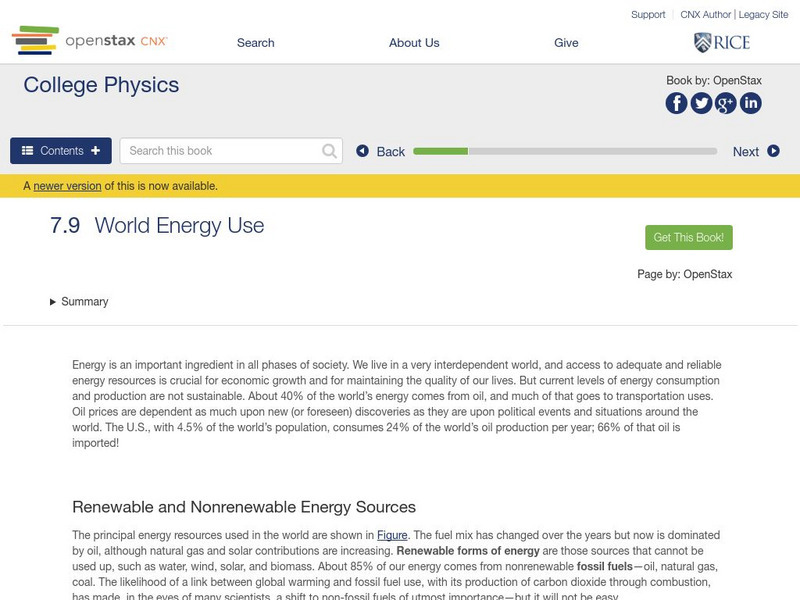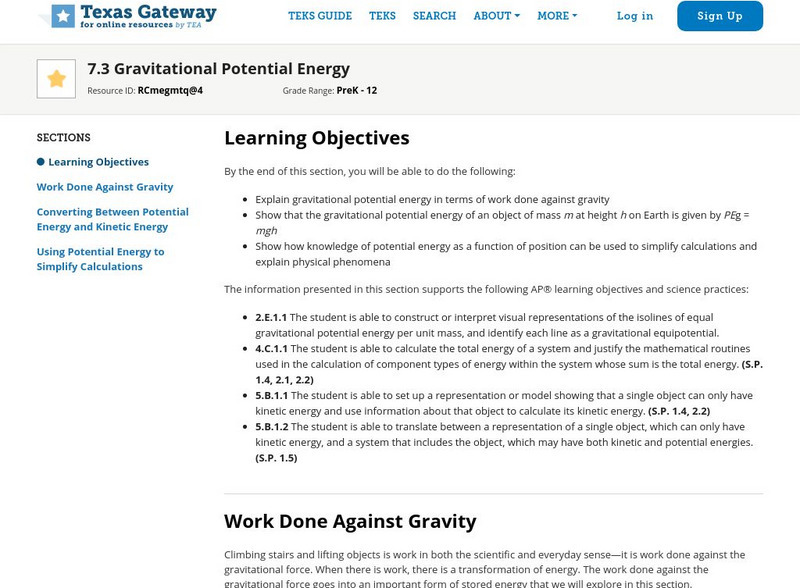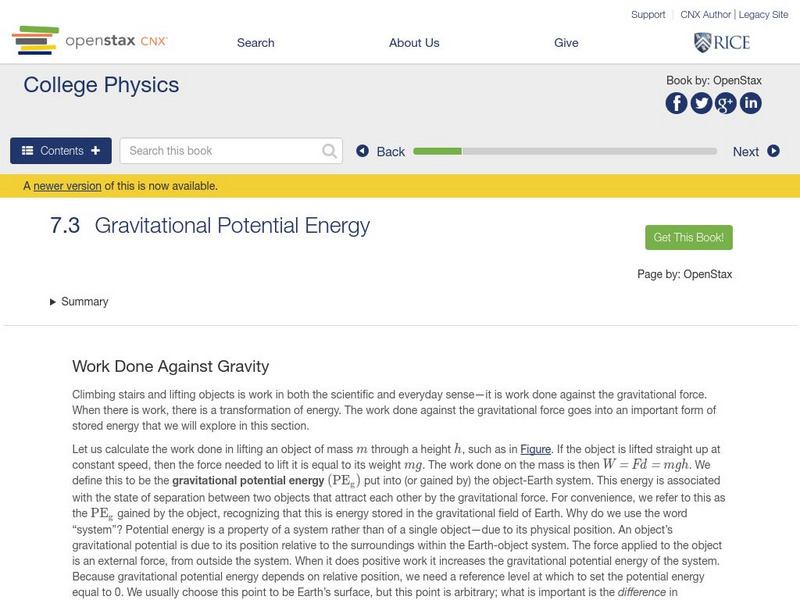OpenStax
Open Stax: World Energy Use
From a chapter on work and energy in a Physics textbook. This section of the chapter covers the difference between renewable and nonrenewable energy resources, the growth in the world's energy consumption, and the link between energy use...
OpenStax
Open Stax: College Physics: Heat
In this section of the textbook, find information about how heat and work transfer energy. Also understand how a heat transfer is related to temperature and what mechanical equivalent of heat relates to work and heat transfer. Book can...
Georgia Department of Education
Ga Virtual Learning: Ap Physics 1: Work, Energy, and Power
The mathematical model for the relationships between work and energy serves to model physical problems and, more importantly, predict natural and man-made phenomena. Students discover the relationships which serve as a powerful...
Physics Classroom
The Physics Classroom: Work and Energy: Energy Transformation for a Pendulum
The motion of a pendulum is a classic example of mechanical energy conservation. See the mechanics at work here in this animation.
Learn AP Physics
Learn Ap Physics: Physics B: Work and Energy
A site dedicated to help students prepare for the AP Physics B test. This specific site reviews work and energy including work-energy theorem, conservation of energy, potential energy and power. Site contains links to video lectures and...
Read Works
Read Works: The Simple Physics of Soccer
[Free Registration/Login Required] An informational text explaining the physics behind soccer. A question sheet is available to help students build skills in reading comprehension.
Khan Academy
Khan Academy: What Are Energy and Work?
Here we learn what work and energy mean in physics and how they are related.
Physics Classroom
The Physics Classroom: Work and Energy: How Far Will It Skid?
Most driver's education classes teach future drivers that the stopping distance of a skidding car is directly proportional to the square of the speed of the car. See how this situation plays out in this animation.
Science Struck
Science Struck: A Comprehensive List of All the Physics Formulas
Provides a long list of physics formulas for easy reference.
Nobel Media AB
The Nobel Prize: The Nobel Prize in Physics 1961 Presentation Speech
The speech given by Prof I. Waller at the presentation of the Nobel Prize to Robert Hofstadter. Details the work both of Hofstadter and of Rudolf Mossbauer, who shared the prize. Elegantly said, with plenty of scientific detail.
Physics Classroom
The Physics Classroom: Work, Energy, and Power: Definition/mathematics of Work
Through examples and interactive practice problems, motion will be approached from the perspective of work and energy.
Texas Education Agency
Texas Gateway: Ap Physics: Gravitational Potential Energy
By the end of this section, you will be able to explain gravitational potential energy in terms of work done against gravity, show that the gravitational potential energy of an object of mass m at height h on Earth is given by PEg = mgh,...
Physics Classroom
The Physics Classroom: The Work Energy Theorem
This page explores the quantitative relationship between work and mechanical energy in situations in which there are no external forces doing work. It is a basic analysis of situations in which mechanical energy is conserved. Examples...
Texas Education Agency
Texas Gateway: Ap Physics: Conservative Forces and Potential Energy
By the end of this section, you will be able to define conservative force, potential energy, and mechanical energy; explain the potential energy of a spring in terms of its compression when Hooke's law applies; and use the work-energy...
OpenStax
Open Stax: Kinetic Energy and the Work Energy Theorem
In the following interactive students will begin to explain work as a transfer of energy and net work as the work done by the net force. They will also explain and apply the work-energy theorem.
University of New South Wales (Australia)
University of New South Wales: School of Physics: Physclips: Energy and Power
Learn about energy and power in this learning module that contains videos and animation.
CK-12 Foundation
Ck 12 Exploration Series: Simulations: Physics: High Energy Particles
[Free Registration/Login Required] A video module that allows students to uncover the relationship between speed and kinetic energy in the context of a particle accelerator.
OpenStax
Open Stax: Work, Energy, and Power in Humans
In the following interactive students will begin to explain the human body's consumption of energy when at rest vs. when engaged in activities that do useful work. They will also calculate the conversion of chemical energy in food into...
OpenStax
Open Stax: Gravitational Potential Energy
In the following tutorial, students learn about gravitational potential energy in terms of work done against gravity. They will be able to show how knowledge of the potential energy as a function of position can be used to simplify...
OpenStax
Open Stax: Potential Energy and Conservative Forces
In the following interactive students will define conservative force, potential energy, and mechanical energy. They will explain the potential energy of a spring in terms of its compression when Hooke's Law applies. Students will also...
OpenStax
Open Stax: Conservation of Energy
In the following tutorial, students will learn about the law of conservation of energy. They will read about some of the many forms of energy. They will understand the definition of efficiency of an energy conversion process as the...
CK-12 Foundation
Ck 12 Exploration Series: Simulations: Physics: Ramp and Piano
[Free Registration/Login Required] This module has students using a simple machine to learn about the relationship between work, force, and energy.
CK-12 Foundation
Ck 12 Exploration Series: Simulations: Physics: Block and Tackle
[Free Registration/Login Required] A video module where students learn about the relationship between force, work, energy, and mechanical advantage using a simple machine.
CK-12 Foundation
Ck 12: Conservation of Energy
[Free Registration/Login may be required to access all resource tools.] Students investigate how all types of energy, including work, relate to each other and are conserved in a closed system.


















